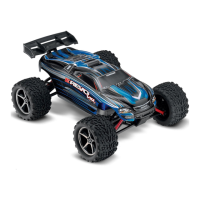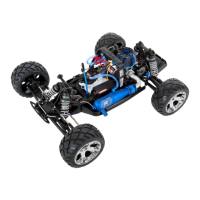
Do you have a question about the Traxxas Revo 3.3 53097 and is the answer not in the manual?
| Scale | 1/10 |
|---|---|
| Fuel Tank Capacity | 150cc |
| Engine | TRX 3.3 Racing Engine |
| Displacement | 0.20 cubic inches (3.3cc) |
| Drive System | 4WD |
| Suspension | Independent |
| Differential | Sealed diffs front and rear |
| Servos | 2075 |
| Transmission | Two-Speed Forward Only |
| Radio System | TQ 2.4GHz |
Contact Traxxas Technical Support for model assistance.
Essential warnings about fuel, heat, operation areas, and radio interference.
Guidelines for safe charging and handling of NiMH battery packs.
Details tools provided with the Revo for maintenance and setup.
Suggests extra tools for an R/C toolbox to enhance maintenance.
Lists separate items necessary for operation and maintenance.
Introduces the TQi transmitter and its features for R/C enthusiasts.
Explains key terms related to the radio and power systems.
Advises on antenna handling and general radio system safety.
Identifies key parts of the transmitter and receiver.
Illustrates how the radio system components are wired in the Revo.
Step-by-step guide for installing AA batteries in the TQi transmitter.
Instructions for charging the 7.2V NiMH battery pack for the receiver.
Precautions for maintaining NiMH receiver pack performance and longevity.
Essential rules for turning the system on/off and battery use.
Describes the failsafe function that prevents loss of control.
Identifies and explains the functions of the transmitter's controls.
Covers throttle neutral and steering trim adjustments.
Guide to checking factory settings and making basic alignment adjustments.
Steps to verify the radio system works properly at a distance.
Explains how to adjust steering sensitivity using the Multi-Function knob.
Instructions for re-binding the transmitter and receiver if necessary.
Adjusting steering sensitivity for better handling on different surfaces.
Guide to correctly installing the receiver antenna for maximum range.
Instructions for programming the OptiDrive Electronic Shift Module.
Describes the meaning of the different LED color codes for OptiDrive.
Introduces the TRX 3.3 Racing Engine's performance and design.
Details the critical break-in procedure for optimal engine life.
Explains the importance and schedule for air filter cleaning.
Procedure to protect the engine from corrosion after use.
Labeled diagram showing the parts of the TRX 3.3 Racing Engine.
Provides definitions for nitro R/C engine terminology.
Information on choosing and using appropriate fuel for the engine.
Explains the differences and effects of various nitro percentages.
Discusses the use of non-Traxxas fuels and potential implications.
Guidelines for safe handling, storage, and disposal of fuel.
Step-by-step instructions for filling the fuel tank using the dispenser bottle.
Details the air filter's components and importance for engine life.
Steps for cleaning the pre-filter element after each hour of operation.
Steps for cleaning the primary filter element after 3-4 hours of operation.
Explains the carburetor's role in controlling speed and air/fuel ratio.
Details the function of high-speed and low-speed needles for fuel mixture control.
Provides factory preset carburetor adjustments for break-in.
Explains the features and benefits of the EZ-Start system.
Instructions for charging the 7.2V battery pack for the EZ-Start.
Notes on using AC peak-detecting chargers and avoiding timed chargers.
Step-by-step guide for installing the EZ-Start battery in the model.
Explains the Smart Start™ protection circuitry and its function.
Emphasizes the need for a fully charged battery for starting.
Procedures for safely stopping the engine using the fuel line clamp.
Outlines the critical break-in process for optimal engine performance.
Guides on preparing and starting the engine for the very first time.
Describes the specific driving and stopping procedures for each of the first five fuel tanks.
Provides guidance for breaking in the engine in cold temperatures.
Explains how to tune the engine for optimal performance and avoid damage.
Details how to adjust the high-speed needle for optimal performance.
Explains how to adjust the low-speed needle using the pinch test.
Chart correlating atmospheric conditions to fuel mixture adjustments.
How to set the engine's idle speed correctly.
Guidance on adjusting carburetor based on weather and baseline settings.
Using temperature as a guide for tuning adjustments, avoiding overheating.
States the model is ready for driving and lists precautions.
Provides advice on handling, turning, jumping, and obstacle negotiation.
Explains basic suspension tuning concepts and options.
Details spring rates, pre-load adjustment, and ride height.
Explains how to adjust ride height using push rods and mounting holes.
How to adjust pivot ball caps for free operation and no play.
Explains how shock oil viscosity affects damping and how to replace it.
Step-by-step instructions for disassembling and refilling shocks.
Emphasizes the importance of precise alignment adjustments.
How to adjust the toe-in or toe-out angle of the wheels.
How to adjust the static camber angle of the wheels.
Specifies maximum toe and camber settings based on configuration.
Introduces transmission tuning concepts like slipper clutch and gear ratios.
How to adjust the slipper clutch for drivetrain protection and performance.
How to adjust the shift point for improved acceleration and drivability.
How to set the correct gear mesh between spur gear and clutch bell.
Instructions for removing and installing a new spur gear.
Details the dual servo steering system and servo saver.
How to adjust steering linkages to ensure servos are centered.
How to increase steering system travel for better handling.
Information on optional springs for the servo saver.
How to adjust brake pads and linkage for optimal braking performance.
How to adjust shoulder screws for the correct brake pad gap.
How to adjust the brake linkage to prevent brake drag.
Guidance on checking brake pad wear and when replacement is needed.
Tasks to perform after every hour of running, including air filter and battery.
Procedures for after-run maintenance to prevent corrosion and wear.
Periodic checks for connecting rod, slipper clutch, and piston/sleeve.
Comprehensive steps for after-run maintenance to protect the engine.
Steps to clear excess fuel from a flooded engine.
Procedure to free a piston stuck at top dead center.
Details advanced settings for caster, bump steer, and roll center.
How to adjust the front suspension caster angle for handling.
Explains how caster affects bump steer and how to maintain geometry.
How to adjust the roll center to influence traction and handling.
How to change rocker arms to adjust travel and progressive rate.
A chart detailing toe link end setup for various caster and roll center settings.
How to replace shock pistons to adjust damping.
Step-by-step instructions for disassembling and reassembling shocks.
Covers adjusting gear ratios and differential fluid.
How to adjust gear ratios by changing clutch bell and spur gear.
Information on changing gear sets for transmission ratios.
Applications for using higher viscosity oil in differentials or shocks.
Applications for using lower viscosity oil in differentials or shocks.
Chart showing available gear ratio combinations.
How to tune differentials by changing silicone fluid viscosity.
Instructions for installing optional Long Travel rocker arms.
Introduces the Traxxas Link app for intuitive tuning and telemetry.
Highlights the app's easy-to-use interface for controlling model settings.
Explains how telemetry sensors display real-time data like speed and RPM.
How Traxxas Link manages settings for up to 30 different models.
Steps to pair the TQi transmitter with the Link Wireless Module.
Explains the mode that prevents accidental runaway with throttle trim.
Describes the failsafe function that returns throttle to neutral on signal loss.
Steps to reset the TQi transmitter to its original factory settings.
Lists tuning adjustments accessible via the app or transmitter.
How to adjust the amount of servo travel for steering.
How to adjust throttle sensitivity for smoother control.
How to set the maximum travel limits for steering and throttle servos.
How to precisely set the neutral point of servos.
How to set the Multi-Function knob to control brake travel.
How to set Multi-Function knob as throttle trim to prevent drag.
How to disable the Multi-Function knob to prevent setting changes.
Steps to lock a receiver in memory to prevent deletion.
How to delete a model from the transmitter's memory.
A visual guide to navigating the transmitter's menu and options.
Quick reference for navigating the transmitter menu for specific adjustments.











